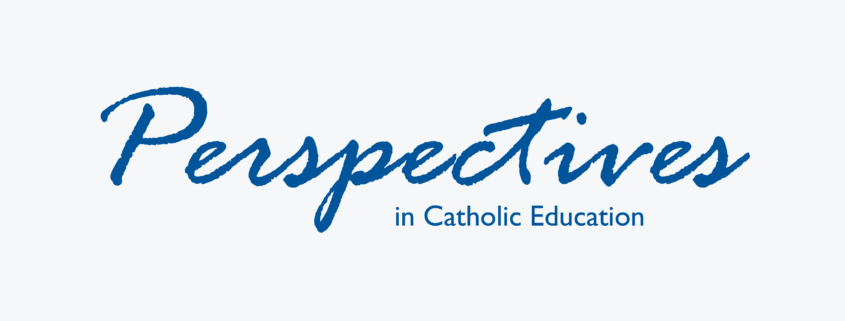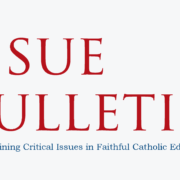The Common Core vs. the Classical Roots of Catholic Education
In 1977, National Review reprinted a 30-year-old speech given by English mystery author, Dorothy Sayers, on the topic of education. In it, she pointed out evident deficiencies in public discourse that revealed fundamental flaws in British education at the time. She whimsically proposed as a remedy a return to the Trivium-based education that formed some of the greatest minds in history, little dreaming that her proposals would be taken seriously. Forty years later, American parents frustrated with an even worse educational situation took her proposal as the basis for a grassroots renewal of a classical approach to education. Beginning with Douglas Wilson’s Logos school in Idaho and the homeschooling efforts of people like Laura Berquist (Designing Your Own Classical Curriculum) and Susan Wise Bauer (The Well- Trained Mind), classical education has become the way for hundreds of schools and tens of thousands of homeschooling families.
At the heart of Sayers’ proposal was the idea that primary and secondary education should be less focused on passing on the information needed to master prescribed subjects and more focused on making students capable and desirous of life-long learning. The Common Core State Standards Initiative (CCSSI) for English Language Arts and Literacy, at first glance, might appear to share her goal. The standards seem less concerned with passing on particular in- formation than with forming a certain kind of person, the “critical thinker.” Looking to make students ready for “college and career,” the CCSSI begins with the view that success in our information age demands the ability to sort through, make sense of, and judge the “staggering amount of information available today in print and digitally.” This raises the question for classical educators and any Catholic schools that value their naturally classical roots: Should they embrace the Common Core? Is the secular world finally waking up to the needs that motivated parents have been trying to address for the last 35 years?
Catholic schools’ success historically has been based in a classical approach to education, even where substantially compromised by state standards and new theories of education. Today’s best schools retain at least some key elements of classical education, especially with regard to the study of religion, history, and literature. A closer look at the goals and methods of the Common Core reveals that they are fundamentally at odds with the discovery of Truth at the heart of an authentically Catholic education.
Ironically, it seems that the developers of the CCSSI would be sympathetic to Sayers’ criticism of the failures of modern education:
Has it ever struck you as odd, or unfortunate, that today, when the proportion of literacy throughout Western Europe is higher than it has ever been, people should have become susceptible to the influence of advertisement and mass pro- paganda to an extent hitherto unheard of and unimagined?
Are you often bothered by coming across grown-up men and women who seem unable to distinguish between a book that is sound, scholarly, and properly documented, and one that is, to any trained eye, very conspicuously none of these things? Or who cannot handle a library catalogue? Or who, when faced with a book of reference, betray a curious inability to extract from it the passages relevant to the particular question which interests them?
The Common Core aims to address these issues by habituating students to “reflexively dem- onstrate the cogent reasoning and use of evidence that is essential to both private deliberation and responsible citizenship in a democratic republic.” The CCSSI states that “(s)tudents are engaged and open-minded—but discerning—readers and listeners. They work diligently to understand precisely what an author or speaker is saying, but they also question an author ’s or speaker ’s assumptions and premises and assess the veracity of claims and the soundness of reasoning.”
So far, so good. But a deeper look shows that Sayers was not on the minds of the authors (nor were Adler, Hirsch, Bauer, etc., who are conspicuously missing from the extensive bibliographies cited in the Appendices). The thousands of contemporary classical educators inspired by Sayers should take a hard look at the approaches proposed to achieve these goals. Some of these will be found in the standards themselves, even more in the assessment-driven, industrial way the CCSSI has begun to be implemented. One important difference they will notice is that Sayers emphasized that a renewed Trivium-based education would approach language development in a way natural to the young. In the grammar stage younger children (up to around age 11) naturally learn by absorbing language and facts. They are not ready for critical thinking; they are ready to trustingly accept whatever is presented to them in an orderly, engaging manner. Learning by heart and careful observation are key powers to be developed, not just with facts and vocabulary, but with the beautiful rhythms and rich images of the best poetry and prose. By contrast, though the CCSSI proposes some excellent works be introduced to the young, learning by heart seems to play no role. The Common Core intends to make critical thinking, embodied in literary analysis, the focus of every grade level. Sayers strongly warns against this approach:
The modern tendency is to try and force rational explanations on a child’s mind at too early an age. Intelligent questions, spontaneously asked, should, of course, receive an immediate and rational answer; but it is a great mistake to suppose that a child cannot readily enjoy and remember things that are beyond his power to analyze—particularly if those things have a strong imaginative appeal (as, for example, “Kubla Khan”), an attractive jingle (like some of the memory-rhymes for Latin genders), or an abundance of rich, resounding polysyllables (like the Quicunque vult).
In the CCSSI, every grade level is dominated by dialectical/logical/critical activities that are most appropriate for what Sayers described as the “Pert” age, those pre-adolescent and early adolescent years of questioning and challenging. Common Core methods thus push young children into finding their own truths, and also neglect what is natural to older adolescents at the Rhetorical stage. The desire to investigate and formulate ideas about what matters to the student. The dialectical stage begins to close as students desire to really know what they have begun to care about. “Towards the close of this stage, the pupils will probably be beginning to discover for themselves that their knowledge and experience are insufficient, and that their trained intelligences need a great deal more material to chew upon. The imagination—usually dormant during the Pert age—will reawaken, and prompt them to suspect the limitations of logic and reason.” Sayers emphasizes that “the attitude of the teachers” will be crucial; they must see the goal of the education and be aware of how each student is progressing towards that goal. This means that teachers must have much more freedom from bureaucratic assessment if they are going to succeed. Implementation of the CCSSI in our assessment-obsessed educational culture is sure to mean much more harassment for teachers and much less time for them to actually work with students.
Sayers insists that the Rhetorical stage of development demands greater freedom on the part of the student to pursue subjects whose truth really matters to them. This is because Sayers’ ultimate goal, (one which classical schools have embraced) is to provide for each human being to flourish as individuals who can contribute to the common life but who are not in service to it. This puts her, and all classical educators, fundamentally at odds with the CCSSI. Although the Common Core Standards seem to have similar aims for student formation, the overall goal limits and colors everything in them. “The standards are designed to be robust and relevant to the real world, reflecting the knowledge and skills that our young people need for success in college and careers. With American students fully prepared for the future, our communities will be best positioned to compete successfully in the global economy.” The overriding economic concerns permeate the standards. The critical thinking skills are finally about economic success, not just for the individual, but for the sake of national economic growth.
This latter consideration has raised a great wave of outcry and concern from the classical community, and with good reason. In the 1950s, Bell Telephone instituted a 10-month intensive introduction to liberal arts education to its most promising, technically-trained employees. The program was judged a great success by participants and the professors who organized it. Bell, however, was not pleased with the outcome:
But Bell gradually withdrew its support after yet another positive assessment found that while executives came out of the program more confident and more intellectually engaged, they were also less interested in putting the company’s bottom line ahead of their commitments to their families and communities. By 1960, the Institute of Humanistic Studies for Executives was finished.
“The end is the cause of causes,” and the temporal, economic goal of the Common Core will drive it to neglect—if not positively avoid—the means that would truly open minds and hearts to what is most humanly fulfilling. St. Jerome Academy in the Archdiocese of Washington has gained national attention for its success after choosing a decidedly different path from the assessment-driven, fragmented education of government schools. Faced with declining enrollment and on the verge of shutting its doors, St. Jerome converted from a traditional parochial school to a Catholic classical school. Blessed with a number of CUA professors as parishioners, the school benefitted from a dedicated team of educators, theologians, and philosophers who developed a comprehensive new educational plan in less than one year. St. Jerome’s curriculum goes beyond Sayers’ essay, incorporating her insights but setting them in a broader vision of the goals of a Catholic classical education:
St. Jerome School educates children in the truest and fullest sense by giving them the necessary tools of learning and by fostering wonder and love for all that is genuinely true, good, and beautiful. …We seek to incorporate our students into the wisdom of two thousand years of Catholic thought, history, culture, and arts so that they might understand themselves and their world in the light of the truth and acquire the character to live happy and integrated lives in the service of God and others.
The Common Core also wants to educate for life, but it articulates life’s highest goals as career success and productive contribution to the global economy. Cultural tolerance is another crucial outcome of the Common Core. Content must be drawn from a wide-range of cultures, leading students to be able to work well with the variety of cultural and personal viewpoints of their future corporate fellow laborers.
Students appreciate that the twenty-first-century classroom and workplace are settings in which people from often widely divergent cultures and who represent diverse experiences and perspectives must learn and work together. Students actively seek to understand other perspectives and cultures through reading and listening, and they are able to communicate effectively with people of varied backgrounds. They evaluate other points of view critically and constructively. Through reading great classic and contemporary works of literature representative of a variety of periods, cultures, and worldviews, students can vicariously inhabit worlds and have experiences much different than their own.
Of course, as in many areas, the CCSSI is here proposing some things that any teacher would want for her students. However, under the guise of mutual understanding, curricular materials are likely to usher in an aggressively secular orthodoxy. Without a strong commitment to the existence of objective truth and an awareness of the contributions of Catholic civilization, CCSSI will lead us to the sort of openness that is the virtue of the “dictatorship of relativism,” as Alan Bloom warned us in The Closing of the American Mind:
Openness—and the relativism that makes it the only plausible stance in the face of various claims to truth and various ways of life and kinds of human beings— is the great insight of our times. The true believer is the real danger.
The Common Core State Standards Initiative intends to form literate, thoughtful, critical readers capable of understanding and judging the best literature and the richest informational literature. But not only are its goals limited—even subversive with respect to a Catholic education—it represents a massive educational project that has not been tried. Catholic classical educators have now more than three decades of experience and over two thousand years of expertise to draw on. Now is not the time to submit children enrolled in any Catholic school to untested, yet no doubt very constraining, shackles.
To the extent that any Catholic school teaches the fullness of Truth in the faith, it offers a piece of the classical vision in its search for wisdom and virtue. Over recent decades, however, many Catholic schools have adopted secular curricula as well as secular instruction and assessment techniques that undermine the unity of faith and reason. In this trend they have followed the pattern about which Sayers warned, with the focus on conveying information needed to master prescribed subjects. By contrast, the time-tested classical approach engages children to discover the truth of reality, both visible and invisible. This is active learning, not passive learning. It cultivates habits of mind that allow the human person to discern what is true, good and beautiful, to glimpse the transcendent. It awakens the soul.
Ironically, it may be the Common Core State Standards Initiative that will awaken all Catholic educators to reject encroaching secular content and methods, and to rediscover the riches of their own tradition. Given the unique, supernatural beauty of the Catholic faith, they should be decidedly skeptical of anything that bills itself as “common.”


 St. Agnes School, St. Paul, MN
St. Agnes School, St. Paul, MN 

